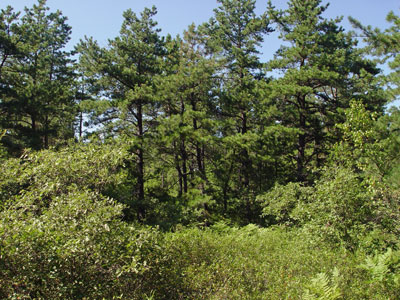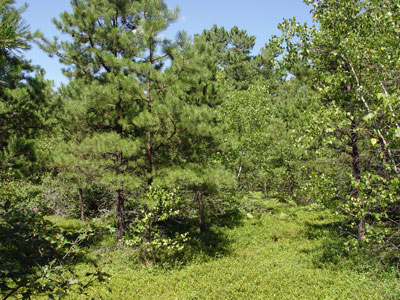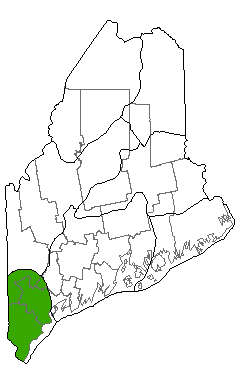DACF Home → Bureaus & Programs → Maine Natural Areas Program → Communities, Plants, and Animals → Natural Community Fact Sheets → Pitch Pine - Scrub Oak Barren
Printer Friendly Fact Sheet - 880 KB pdf (Get a free copy of Adobe Acrobat Reader)
Pitch Pine - Scrub Oak Barren
Scientific Name: Pitch Pine - Scrub Oak Barren; State Rank: S2

- Community Description
- Soil and Site Characteristics
- Diagnostics
- Similar Types
- Conservation, Wildlife and Management Considerations
- Distribution
- Characteristic Plants
- Associated Rare Plants
- Associated Rare Animals
- Examples on Conservation Lands You Can Visit
Community Description: This woodland type ranges from very open to nearly closed canopy (25-75% closure) in which pitch pine is dominant ( up to 50% cover ). Red maple is frequent but rarely abundant in the canopy. In openings among the trees, a dense shrub/sapling layer of scrub oak is typical. Gray birch may be a prominent feature of the shrub layer, and shrubs are locally dense. A low layer of heath shrubs dominated by lowbush or velvet-leaf blueberry is usually present. Bracken fern and woodland sedge are characteristic herbs. Bryoids are virtually absent. Vegetation is typically very patchy, with some areas clearly pitch pine dominated and others areas extensive thickets of scrub oak. Nonforested openings with blueberry and lichens may occur within the barrens. Back to top.
Soil and Site Characteristics: Sites occur on nutrient poor soils of glacial outwash plains or moraines south of 44 degrees latitude. Topography is flat to undulating. The xeric to dry-mesic, sandy soils are acidic (pH usually <5.0) and have little organic matter. Fire is an important factor in maintaining this community. Back to top.

Diagnostics: These are pitch pine dominated partially forested areas which develop on sands or glacial outwash deposits, not on stabilized coastal dunes. Scrub oak is common and locally dominant in the shrub layer. Back to top.
Similar Types: Pitch Pine Woodlands can be floristically similar but occur on bedrock, not on deep sandy soils. Pitch Pine Dune Woodlands occur on stabilized sand dunes along the coast. They also lack a well developed heath shrub layer. Pitch Pine - Heath Barrens share many species but lack the scrub oak layer (scrub oak may be present but only at low cover). Pitch Pine Bogs are wetlands, with at least a shallow peat substrate. Back to top.
Conservation, Wildlife and Management Considerations:
This community type is dependent upon periodic fires to eliminate competing tree species and prevent succession to an Oak - Pine Forest. Because of fire suppression in the last century, this community type has become very rare. Relatively large areas are required to maintain this dynamic community and its associated rare animal species. Most of the large sites in the state have been fragmented by permanent conversion to residential areas or to sand and gravel pits.
Birds such as the whip-poor-will, eastern towhee, pine warbler, and prairie warbler may prefer this open habitat. This community type includes a rich array of rare butterflies and moths that use pitch pine or scrub oak as their larval host plant, including the southern pine sphinx, pine pinion, oblique zale, the buckmoth, Edward's hairstreak, pine barrens zale, pine barrens itame, and sleepy dusky wing. Back to top.
Distribution: Primarily southern Maine ( Eastern Broadleaf Forest Province). Extends southward and southwestward from the state along the Atlantic coastal plain. Landscape Pattern: Large Patch. Back to top.


Characteristic Plants: These plants are frequently found in this community type. Those with an asterisk are often diagnostic of this community.
- Canopy
- Gray birch
- Pitch pine*
- Red maple
- Sapling/shrub
- Gray birch
- Pitch pine
- Scrub oak*
- Shadbush
- Sweetfern
- Wild-raisin
- Dwarf Shrub
- Lowbush blueberry*
- Sheep laurel
- Velvet-leaf blueberry
- Herb
- Bracken fern*
- Canada mayflower
- Mayflower
- Sharp-pointed ricegrass
- Wintergreen*
- Woodland sedge
- Bryoid
- Large hair-cap moss
- Edward's hairstreak
- Oblique zale
- Pine barrens itame
- Pine barrens zale
- Pine barrens zanclognatha
- Pine pinion
- Pine-devil moth
- Pink sallow
- Similar underwing
- Sleepy duskywing
- Southern pine sphinx
- The buckmoth
- Twilight moth
- Whip-poor-will
Examples on Conservation Lands You Can Visit
| Example | County |
|---|---|
| Brownfield Bog Wildlife Management Area | Oxford Co. |
| Kennebunk Plains Preserve | York Co. |
| Killick Pond Wildlife Management Area | York Co. | Waterboro Barrens Preserve | York Co. |